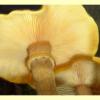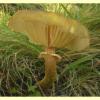




_AE_18_sml.jpg)
Individual mycelia of A. luteobubalina can occupy areas of up to several hectares (Kile, 1983).
Bougher, N.L. & Syme, K. (1998), Fungi of Southern Australia. University of Western Australia Press, Nedlands. [Description, Illustration and Microcharacters of A. luteobubalina]
Coetzee, M.P.A., Wingfield, B.D., Bloomer, P., Ridley, G.S., Kile, G.A. & Wingfield, M.J. (2001), Phylogenetic relationships of Australian and New Zealand Armillaria species, Mycologia 93: 887–896.
Fuhrer, B. (2005), A Field Guide to Australian Fungi. Bloomings Books, Hawthorn. [Description and Illustration of A. fumosa, A. hinnulea, A. luteobubalina, A. novaezelandiae and A. pallidula]
Fuhrer, B. & Robinson, R. (1992), Rainforest Fungi of Tasmania and South-east Australia. CSIRO Press, East Melbourne. [Illustration of A. novae-zelandiae]
Grey, P. & Grey, E. (2005), Fungi Down Under. Fungimap, South Yarra. [Description, Illustration and Map for A. luteobubalina]
Grgurinovic, C.A. (1997a), Larger Fungi of South Australia. The Botanic Gardens of Adelaide and State Herbarium and The Flora and Fauna of South Australia Handbooks Committee, Adelaide. [Description, B&W Illustration and Microcharacters of A. luteobubalina]
Grgurinovic, C.A. & Mallett, K. (eds) (1996), Fungi of Australia, Volume 1A. Australian Biological Resources Study, Canberra. [Illustration of A. luteobubalina]
Hood, I.A. (2003), An Introduction to Fungi on Wood in Queensland. University of New England, School of Environmental Sciences and Natural Resources Management, Armidale. [Description, Illustration and B&W Illustration of A. luteobubalina]
Kile, G.A. (1983), Identification of genotypes and the clonal development of Armillaria luteobubalina Watling & Kile in eucalypt forests, Austral. J. Bot. 31: 657–671.
Kile, G.A. & Watling, R. (1981), An expanded concept of Armillaria luteobubalina, Trans. Brit. Mycol. Soc. 77: 75–83. [Description, B&W Illustration and Microcharacters of A. luteobubalina]
Kile, G.A. & Watling, R. (1983), Armillaria species from south-eastern Australia, Trans. Brit. Mycol. Soc. 81: 129–140. [Description, B&W Illustration and Microcharacters of A. fumosa, A. hinnulea and A. novaezelandiae]
Kile, G.A. & Watling, R. (1988), Identification and occurrence of Australian Armillaria species, including A. pallidula sp. nov. and comparative studies between them and non-Australian tropical and Indian Armillaria, Trans. Brit. Mycol. Soc. 91: 305–315. [Description, B&W Illustration and Microcharacters of A. pallidula]
Kile, G.A. & Whalley, A.J.S. (1990), Profiles of fungi 30. Armillaria novae-zelandiae (Stev.) Boesewinkel, Mycologist 4: 147. [Description and Illustration of A. novae-zelandiae]
Marks, G.C., Fuhrer, B.A. & Walters, N.E.M. (Huebner, M.L., ed.) (1982), Tree Diseases in Victoria. Forests Commission Victoria, Melbourne.[Illustration of A. luteobubalina and Armillaria sp.]
McCann, I.R. (2003), Australian Fungi Illustrated. Macdown Productions, Vermont. [Illustration of A. hinnulea, A. luteobubalina (also as Armillaria sp., p. 42) and A. novaezelandiae]
Podger, F.D., Kile, G.A., Watling, R. & Fryer, J. (1978), Spread and effects of Armillaria luteobubalina sp. nov. in an Australian Eucalyptus regnans plantation, Trans. Brit. Mycol. Soc. 71: 77–87. [Description, B&W Illustration and Microcharacters of A. luteobubalina]
Shaw, C.G., III & Kile, G.A. (eds) (1991), Armillaria Root Disease. Forest Service, United States Department of Agriculture, Washington. [Illustration of A. fumosa, A. luteobubalina and A. pallidula]
Smith-White, J., Summerell, B.A., Gunn, L.V., Rinzin, C., Porter, C. & Burgess, L. (2002), Molecular detection and differentiation of Australian Armillaria species, Australas. Pl. Pathol. 31: 75–79.
Young, A.M. (2005b), A Field Guide to the Fungi of Australia. University of New South Wales Press, Sydney. [Description and Illustration of A. luteobubalina, and Description and B&W Illustration of A. novaezelandiae]
